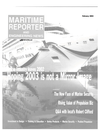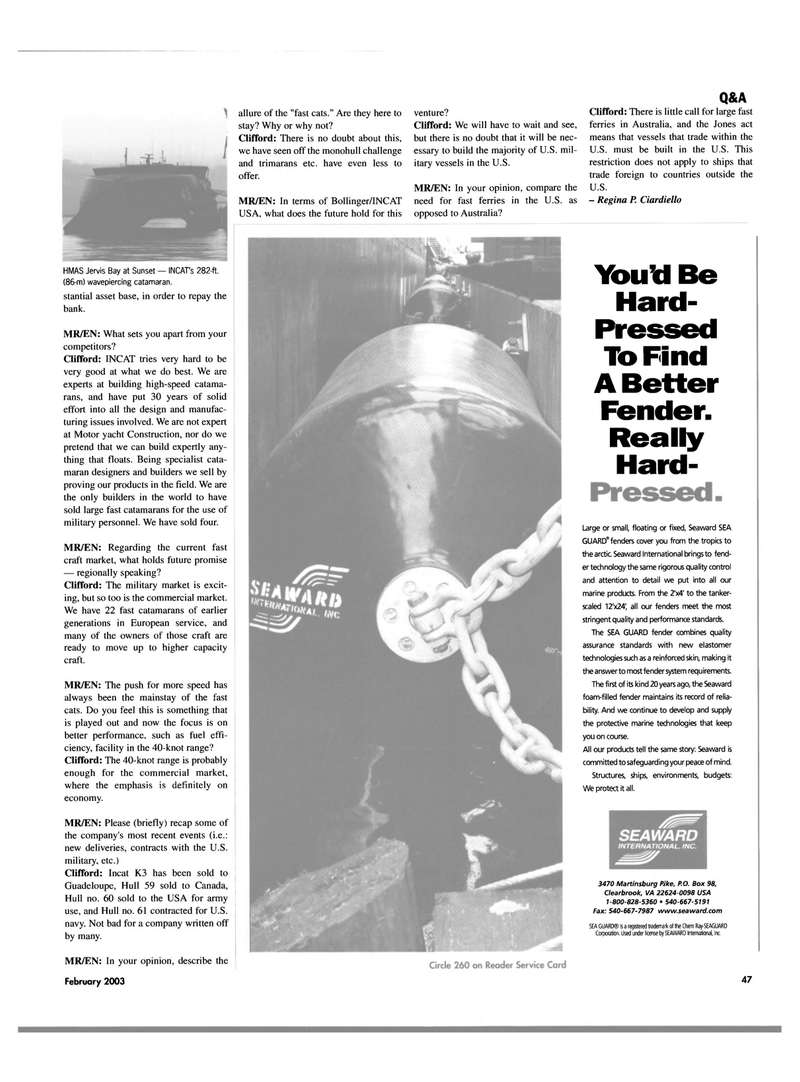
Page 47: of Maritime Reporter Magazine (February 2003)
Read this page in Pdf, Flash or Html5 edition of February 2003 Maritime Reporter Magazine
HMAS Jervis Bay at Sunset — INCAT's 282-ft. (86-m) wavepiercing catamaran. stantial asset base, in order to repay the bank.
MR/EN: What sets you apart from your competitors?
Clifford: INCAT tries very hard to be very good at what we do best. We are experts at building high-speed catama- rans, and have put 30 years of solid effort into all the design and manufac- turing issues involved. We are not expert at Motor yacht Construction, nor do we pretend that we can build expertly any- thing that floats. Being specialist cata- maran designers and builders we sell by proving our products in the field. We are the only builders in the world to have sold large fast catamarans for the use of military personnel. We have sold four.
MR/EN: Regarding the current fast craft market, what holds future promise — regionally speaking?
Clifford: The military market is excit- ing, but so too is the commercial market.
We have 22 fast catamarans of earlier generations in European service, and many of the owners of those craft are ready to move up to higher capacity craft.
MR/EN: The push for more speed has always been the mainstay of the fast cats. Do you feel this is something that is played out and now the focus is on better performance, such as fuel effi- ciency, facility in the 40-knot range?
Clifford: The 40-knot range is probably enough for the commercial market, where the emphasis is definitely on economy.
MR/EN: Please (briefly) recap some of the company's most recent events (i.e.: new deliveries, contracts with the U.S. military, etc.)
Clifford: Incat K3 has been sold to
Guadeloupe, Hull 59 sold to Canada,
Hull no. 60 sold to the USA for army use, and Hull no. 61 contracted for U.S. navy. Not bad for a company written off by many.
MR/EN: In your opinion, describe the
February 2003 allure of the "fast cats." Are they here to stay? Why or why not?
Clifford: There is no doubt about this, we have seen off the monohull challenge and trimarans etc. have even less to offer.
MR/EN: In terms of Bollinger/INCAT
USA, what does the future hold for this venture?
Clifford: We will have to wait and see, but there is no doubt that it will be nec- essary to build the majority of U.S. mil- itary vessels in the U.S.
MR/EN: In your opinion, compare the need for fast ferries in the U.S. as opposed to Australia?
Q&A
Clifford: There is little call for large fast ferries in Australia, and the Jones act means that vessels that trade within the
U.S. must be built in the U.S. This restriction does not apply to ships that trade foreign to countries outside the
U.S. - Regina P. Ciardiello
YouUBe
Hard-
Pressed
To Find
A Better
Fender.
Really
Hard-
Large or small, floating or fixed, Seaward SEA
GUARD® fenders cover you from the tropics to the arctic. Seaward International brings to fend- er technology the same rigorous quality control and attention to detail we put into all our marine products. From the 2'x4' to the tanker- scaled 12'x24', all our fenders meet the most stringent quality and performance standards.
The SEA GUARD fender combines quality assurance standards with new elastomer technologies such as a reinforced skin, making it the answerto most fender system requirements.
The first of its kind 20 years ago, the Seaward foam-filled fender maintains its record of relia- bility. And we continue to develop and supply the protective marine technologies that keep you on course.
All our products tell the same story: Seaward is committed to safeguarding your peace of mind.
Structures, ships, environments, budgets:
We protect it all. 3470 Martinsburg Pike, P.O. Box 98,
Clearbrook, VA 22624-0098 USA 1-800-828-5360 • 540-667-5191
Fax: 540-667-7987 www.seaward.com
SEA GUARD® Is a registered trademark of the Chem Ray-SEAGUARD
Corporation, Used under license by SEAWARD International, Inc. 47

 46
46

 48
48
